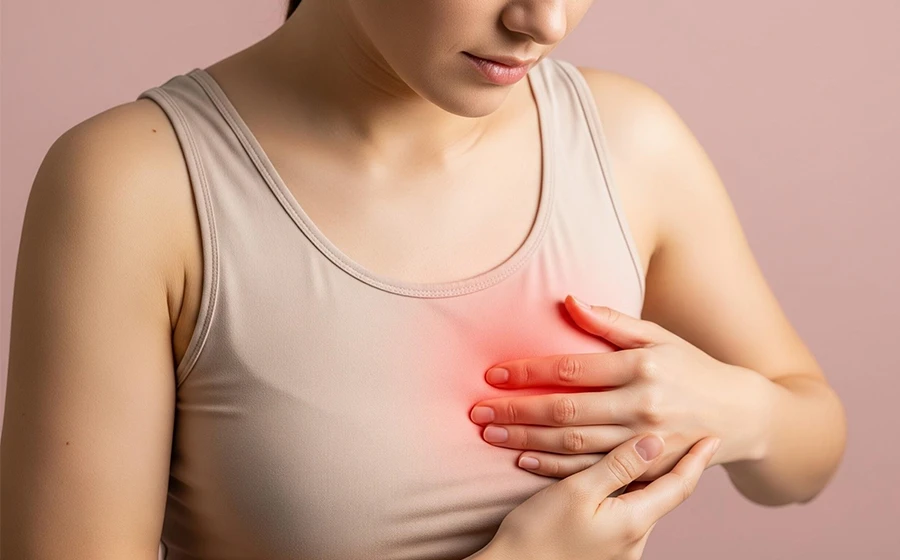Finding a lump in your breast can be alarming, but it’s important to remember that not all lumps are cancerous. Many are benign (non-cancerous) and may not require surgery. However, timely diagnosis and treatment are essential for peace of mind and health. In this blog, we’ll walk you through everything you need to know about breast lumps, from understanding them to removal options, including both surgical and non-surgical approaches.
Understanding Breast Lumps
A breast lump is a growth or localized swelling within the breast that feels different from the surrounding tissue. While some lumps are hard, others may be soft, tender, or even fluid-filled. Many women experience breast lumps due to hormonal changes particularly around menstruation but persistent or unusual lumps should always be evaluated.
Breast lumps can occur in both men and women, though they are far more common in women. Early evaluation by a qualified breast specialist is essential to determine the nature of the lump and its need for removal or monitoring.

When Should You See a Doctor?
If you notice a lumpiness in your breast, it’s crucial to consult a doctor to determine the appropriate course of action. Here are some signs that a lump may require immediate attention:
- A new lump or thickening in your breast or underarm
- Changes in breast size, shape, or appearance
- Skin dimpling or redness
- Nipple discharge (especially if bloody)
- Persistent breast pain
Timely consultation with a breast surgeon in Bangalore can make all the difference, especially if you’re looking for medical and cosmetic expertise in breast lump removal.
Types of Breast Lumps
Breast lumps can vary widely in their cause and consistency. The most common types include:
- Fibroadenomas: These are benign, rubbery lumps commonly found in younger women.
- Cysts: Fluid-filled sacs that can fluctuate in size and tenderness.
- Lipomas: Soft, fatty lumps that are generally painless.
- Breast Abscesses: Often caused by infections, particularly in lactating women.
- Malignant Tumours: Cancerous lumps, typically hard, irregular, and painless.
Understanding the type of lump is the first step toward effective treatment.
Common Reasons for Lumps in Breast
Breast lumps can occur for various reasons, many of which are benign. Hormonal fluctuations, particularly during menstruation or pregnancy, can lead to temporary swelling. Blocked milk ducts or infections like mastitis are common among breastfeeding women. Injuries to the breast may also cause fat necrosis, a firm mass that mimics a tumour but is not dangerous. Lifestyle factors, such as diet and stress, may influence breast tissue changes. However, persistent or unusual lumps should always be evaluated to rule out malignancy.
Signs and Symptoms of a Breast Lump
While some lumps are discovered during routine self-exams, others are identified during clinical exams or imaging studies. Symptoms to watch for include:
- A new lump or thickening in the breast or underarm
- Pain or discomfort, although many cancerous lumps are painless
- Nipple discharge (especially if bloody or clear)
- Changes in the skin over the breast (dimpling, puckering, redness)
- A noticeable change in breast size or shape
If you observe any of these signs, it’s advisable to schedule a consultation with a specialist breast surgeon in Bangalore for a full evaluation.
Diagnosis of Breast Lump
Diagnosis typically begins with a physical examination followed by imaging studies. Mammography is often the first line of screening, especially for women over 40. Ultrasound is commonly used to distinguish solid masses from fluid-filled cysts, while MRI may be recommended for more complex cases.
In cases where the nature of the lump remains uncertain, a biopsy may be performed. This involves taking a small sample of tissue from the lump and analyzing it in a lab to determine whether it is benign or malignant.
Breast Lumps Treatment Options
So, how to remove a breast lump if it turns out to be problematic?
- Watchful Waiting: Some benign lumps, like small fibroadenomas or cysts, may not require immediate removal. Regular monitoring can help ensure there are no changes over time.
- Aspiration or Drainage: If the lump is a fluid-filled cyst, it can often be drained with a fine needle during a quick, in-office procedure.
- Lumpectomy: For solid lumps that require removal, a lumpectomy is often performed. This is a breast-conserving surgery that removes the lump while maintaining the natural shape of the breast. Many patients opt for this when performed by a breast surgeon in Bangalore with cosmetic expertise.
- Mastectomy or Oncology Treatments: In confirmed cancer cases, more extensive procedures such as mastectomy or chemotherapy may be required. These decisions are made collaboratively by oncologists and breast surgeons.
When to See a Doctor?
This bears repeating: if you discover a lump, do not wait. It’s always better to get it evaluated even if it turns out to be harmless. Early diagnosis ensures more treatment options and better outcomes.
If you’re seeking expert guidance and treatment, consulting a trusted breast surgeon in Bangalore can provide you with clarity, options, and peace of mind.
Conclusion
A breast lump requires attention not alarm, but timely action. With accurate diagnosis and the right medical guidance, most breast lumps can be safely managed or removed with minimal disruption. Whether you’re dealing with a benign cyst, a fibroadenoma, or something requiring more specialized care, early evaluation is the key to effective treatment.
If you’re considering surgical removal or want a thorough assessment of a breast lump, consulting with an experienced specialist is essential. Dr. Pinky Devi Ayyappan, a highly regarded breast surgeon in Bangalore, offers expert care tailored to both medical necessity and aesthetic sensitivity.
To ensure clarity, confidence, and the best possible outcome, schedule a consultation with Dr. Pinky Devi Ayyappan today. Your health deserves expert attention.
